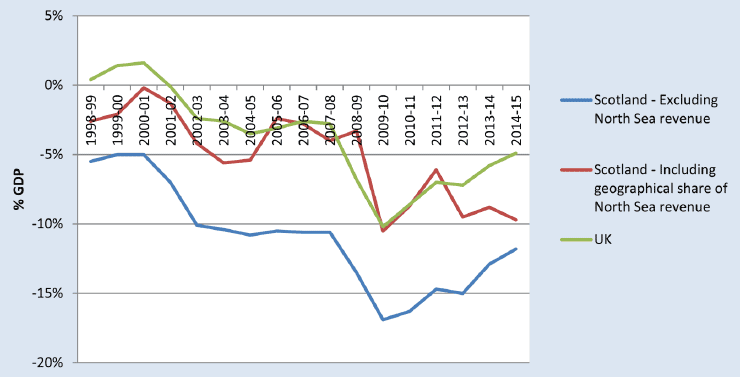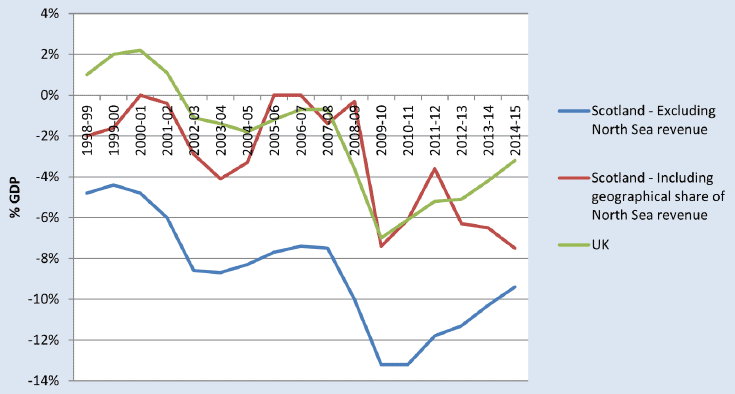Government Expenditure & Revenue Scotland 2014-15
Government Expenditure and Revenue Scotland (GERS) is a National Statistics publication. It estimates the contribution of revenue raised in Scotland toward the goods and services provided for the benefit of Scotland. The estimates in this publication are consistent with the UK Public Sector Finances published in January 2016.
Summary
- Government Expenditure and Revenue Scotland (GERS) is a National Statistics publication. It estimates the contribution of revenue raised in Scotland towards the goods and services provided for the benefit of Scottish residents under the current constitutional arrangements. The estimates are consistent with the UK Public Sector Finances published in January 2016 by the Office for National Statistics (ONS).
- Following user consultation, the publication has a new format this year. Feedback from users of the publication is welcome. A correspondence address is available in the back leaf of the publication. Comments can be emailed to economic.statistics@gov.scot.
Scotland's revenue and expenditure
- Table E.1 shows two estimates of Scotland's public sector revenue presented in GERS: (i) excluding North Sea revenue, and (ii) including an illustrative geographical share of North Sea revenue. Estimates including a population share of North Sea revenue are available in the main chapters.
- Scotland's estimated onshore revenue in 2014-15 was £51.6 billion, growing by 3.2% compared to 2013-14. As a percentage of GDP, onshore revenues fell in 2014-15, as nominal onshore GDP grew faster than revenue. A similar fall is seen for the UK.
- Growth in onshore revenue in Scotland was weaker than for the UK as a whole (3.2% compared to 4.0%). This reflects the fact that capital gains tax is estimated to have grown more slowly in Scotland and that the UK saw an increase in income from student loans issued in England, Wales, and Northern Ireland, which do not affect estimates of Scottish public sector revenue.
- Including an illustrative geographical share of the North Sea, total Scottish revenue fell in cash terms by £607 million in 2014-15. This reflects the decline in North Sea revenue, which fell by 55% compared to 2013-14.
- The fall in Scottish revenue as a percentage of GDP is smaller when including the North Sea, because North Sea GDP also declined, by 31%. The fall in North Sea revenue and GDP occurred because increasing operating costs and falling prices have reduced North Sea profits and therefore GDP. Higher levels of capital investment have further reduced companies' tax liabilities.
Table E.1: Total Revenue: Scotland 2010-11 to 2014-15
| (£ million) | |||||
|---|---|---|---|---|---|
| 2010-11 | 2011-12 | 2012-13 | 2013-14 | 2014-15 | |
| Excluding North Sea revenue | 45,530 | 47,246 | 48,276 | 50,051 | 51,639 |
| Including North Sea revenue (geographical share) | 52,996 | 56,878 | 53,565 | 54,050 | 53,443 |
| As % of UK total revenue | |||||
| Excluding North Sea revenue | 8.1% | 8.1% | 8.1% | 8.1% | 8.0% |
| Including North Sea revenue (geographical share) | 9.2% | 9.6% | 8.9% | 8.6% | 8.2% |
| As % of GDP | |||||
| Excluding North Sea revenue | 36.8% | 36.9% | 37.0% | 37.0% | 36.7% |
| Including North Sea revenue (geographical share) | 36.1% | 37.5% | 35.8% | 35.2% | 34.9% |
| UK | 36.4% | 36.5% | 35.9% | 35.6% | 35.4% |
- Table E.2 below shows estimates of revenue per person for Scotland and the UK. Excluding North Sea revenue, revenue per person in Scotland is lower than in the UK by approximately £200 to £400 per year. Including an illustrative geographical share of North Sea revenue, the difference between revenue per person in Scotland and the UK is quite variable. In the latest year, Scottish revenue per person was slightly lower than the UK average, although the difference is not notable when rounded to the nearest £100.
Table E.2: Revenue per person: Scotland and UK 2010-11 to 2014-15 (£)
| 2010-11 | 2011-12 | 2012-13 | 2013-14 | 2014-15 | |
|---|---|---|---|---|---|
| Scotland | |||||
| Excluding North Sea revenue | 8,600 | 8,900 | 9,100 | 9,400 | 9,600 |
| Including North Sea revenue (geographical share) | 10,100 | 10,700 | 10,100 | 10,100 | 10,000 |
| UK | |||||
| Excluding North Sea revenue | 9,000 | 9,200 | 9,300 | 9,700 | 10,000 |
| Including North Sea revenue | 9,100 | 9,400 | 9,400 | 9,700 | 10,000 |
| Difference (Scotland minus UK) | |||||
| Excluding North Sea revenue | -400 | -300 | -200 | -300 | -400 |
| Including North Sea revenue (geographical share) | 1000 | 1300 | 700 | 400 | 0 |
| Note: Figures rounded to nearest £100 | |||||
- Table E.3 below shows estimates of total managed expenditure for Scotland and the UK, the principle measure of overall public spending in the UK public sector finances. The figures are affected by a one-off increase in expenditure associated with the transfer of the Royal Mail Pension Plan into government in 2012-13. This increased expenditure in this year by £9.5 billion for the UK, and £800 million for Scotland, which represents Scotland's population share. As a result, there is then a relatively large fall in expenditure in 2013-14.
- Scotland's share of UK expenditure is relatively stable over the period, at around 9.3%.
- Expenditure as a share of GDP including an illustrative geographical share of the North Sea increases in 2014-15. This reflects the decline in North Sea GDP discussed above.
Table E.3: Public Sector Total Managed Expenditure: 2010-11 to 2014-15
| 2010-11 | 2011-12 | 2012-13 | 2013-14 | 2014-15 | |
|---|---|---|---|---|---|
| Scotland - £ millions | 65,705 | 66,125 | 67,746 | 67,482 | 68,377 |
| Share of UK (%) | 9.3% | 9.3% | 9.4% | 9.3% | 9.3% |
| As % of GDP | |||||
| Scotland - excluding North Sea | 53.1% | 51.6% | 52.0% | 49.9% | 48.6% |
| Scotland - including geographic share of North Sea | 44.7% | 43.6% | 45.3% | 44.0% | 44.6% |
| UK | 45.0% | 43.4% | 43.0% | 41.4% | 40.3% |
- Table E.4 below shows expenditure per person for Scotland and the UK. Expenditure for Scotland has been consistently higher per person than the UK average over the period.
Table E.4: Total Managed Expenditure per person: Scotland and UK 2010-11 to 2014‑15
| 2010-11 | 2011-12 | 2012-13 | 2013-14 | 2014-15 | |
|---|---|---|---|---|---|
| Scotland (£) | 12,500 | 12,500 | 12,700 | 12,700 | 12,800 |
| UK (£) | 11,300 | 11,200 | 11,300 | 11,300 | 11,400 |
| Difference (Scotland minus UK) (£) | 1,200 | 1,300 | 1,400 | 1,400 | 1,400 |
Note: Figures rounded to nearest £100
Scotland's Overall Fiscal Position
- GERS provides two measures of Scotland's fiscal position, the current budget balance and the net fiscal balance.
- The current budget balance shows the difference between revenue and current expenditure. It measures the degree to which taxpayers meet the cost of paying for day‑to-day public services, excluding capital investment. It is shown in Table E.5 below.
- Excluding North Sea revenue, the current budget balance for Scotland tends to move in line with the figure for the UK, although the deficit in Scotland is typically six to seven percentage points larger. In 2014-15, the Scottish onshore current budget balance improved by 0.8 percentage points, whilst the UK improved by 0.9 percentage points. When including an illustrative geographical share of the North Sea, the movement in Scotland's current budget balance is more variable, and does not follow the same pattern as the UK. Between 2013-14 and 2014-15, Scotland's current budget balance including an illustrative geographical share of North Sea revenue worsened by 1.1 percentage points, reflecting the decline in North Sea revenue in this year.
Table E.5: Current Budget Balance: Scotland and UK 2010-11 to 2014-15
| (£ million) | |||||
|---|---|---|---|---|---|
| 2010-11 | 2011-12 | 2012-13 | 2013-14 | 2014-15 | |
| Scotland - Excluding North Sea | -16,598 | -15,339 | -14,911 | -14,332 | -13,741 |
| Scotland - Including North Sea (geographical share) | -9,132 | -5,707 | -9,622 | -10,332 | -11,937 |
| UK | -94,961 | -83,473 | -84,760 | -73,754 | -59,777 |
| As % of GDP | |||||
| Scotland - Excluding North Sea | -13.4% | -12.0% | -11.5% | -10.6% | -9.8% |
| Scotland - Including North Sea (geographical share) | -6.3% | -3.7% | -6.5% | -6.7% | -7.8% |
| UK | -6.1% | -5.2% | -5.1% | -4.2% | -3.3% |
- The net fiscal balance measures the difference between total public sector expenditure and public sector revenue. It therefore includes public sector capital investment, such as the construction of roads, hospitals, and schools, which yields benefits not just to current taxpayers but also to future taxpayers. It is shown in Table E.6 below.
Table E.6: Net Fiscal Balance: Scotland and UK 2010-11 to 2014-15
| (£ million) | |||||
|---|---|---|---|---|---|
| 2010-11 | 2011-12 | 2012-13 | 2013-14 | 2014-15 | |
| Scotland - Excluding North Sea | -20,175 | -18,879 | -19,470 | -17,431 | -16,738 |
| Scotland - Including North Sea (geographical share) | -12,710 | -9,247 | -14,181 | -13,432 | -14,934 |
| UK | -134,757 | -113,518 | -119,567 | -100,889 | -89,101 |
| As % of GDP | |||||
| Scotland - Excluding North Sea | -16.3% | -14.7% | -15.0% | -12.9% | -11.9% |
| Scotland - Including North Sea (geographical share) | -8.7% | -6.1% | -9.5% | -8.8% | -9.7% |
| UK | -8.6% | -7.0% | -7.2% | -5.8% | -4.9% |
- The net fiscal balance tends to move in the same way as the current budget balance, but is approximately 2 percentage points larger when expressed as a share of GDP. This reflects the fact that capital spending is relatively stable as a share of total spending over time.
- However, the net fiscal balance for the UK worsens from 2011-12 into 2012-13, whilst the current budget balance improves. The same is true for Scotland excluding the North Sea. This reflects the one-off increase in capital spending associated with the Royal Mail Pension Plan discussed above.
- The charts overleaf show the estimates of the current budget balance and net fiscal balance for Scotland and the UK since 1998-99.
- In order to aid user understanding of the GERS results, the database which underpins the expenditure tables in this publication is available on the GERS website.
- Users may wish to be aware that the Office for National Statistics is currently consulting on whether there is demand for a public sector finances publication for the Countries and Regions of the UK. The consultation is available at: https://www.ons.gov.uk/aboutus/whatwedo/statistics/consultationsandsurveys/allconsultationsandsurveys/consultationoncountryandregionalpublicsectorfinances
Net Fiscal Balance: Scotland & UK 1998-99 to 2014-15

Current Budget Balance: Scotland & UK 1998-99 to 2014-15

Contact
Email: Mairi Spowage
There is a problem
Thanks for your feedback